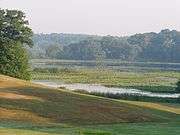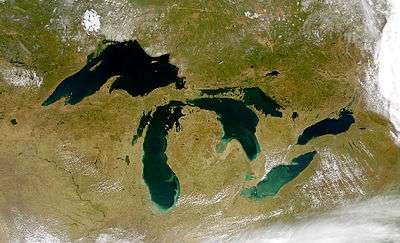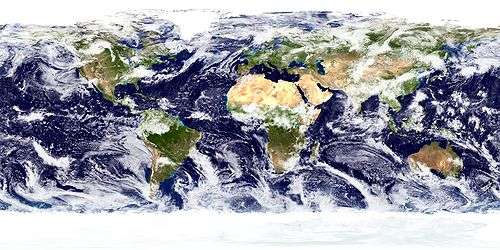Valparaiso Moraine

The Valparaiso Moraine is a terminal moraine that forms an immense U around the Lake Michigan basin in North America. It is a band of high, hilly terrain made up of glacial till and sand. It begins near the border of Wisconsin and Illinois and extends south through Lake, McHenry, Cook, DuPage and Will counties in Illinois, and then turns southeast, entering Indiana. From this point, the moraine curves northeast through Lake, Porter, and LaPorte counties of Indiana into Michigan. It continues into Michigan as far as Montcalm County.[1]
It was formed during the Crown Point Phase of the Wisconsin glaciation. At this time the glacier covering the area had grown thin, so it was restrained by the dolomite rock layers of the Lake Michigan basin. Where the glacier stopped, glacial till and sand was deposited, creating the hills of the moraine. After the Valparaiso Moraine was formed, the glacier retreated and formed the Tinley Moraine.
Many towns in northwest Indiana and northeast Illinois are named after the Valparaiso Moraine or the Tinley Moraine. Also, many small creeks or rivers start in the Valparaiso Moraine. The moraine itself was named after the city of Valparaiso, Indiana, where the moraine is narrower and higher than in other places.
The Valparaiso Moraine forms part of the St. Lawrence Seaway Divide, bounding the Great Lakes Basin. Water on one side of the moraine flows into Lake Michigan, through the Great Lakes, and eventually into the Atlantic Ocean via the Saint Lawrence River, while water on the other side flows into tributaries of the Mississippi River, which eventually flows into the Gulf of Mexico.
History

The Valparaiso Moraine formed as the first major moraine of the Cary substage of the Wisconsin Glacial period (10,000-50,000 years before present).[2] There are three minor moraines that have been identified in northeastern Illinois, the Minooka, Rockdale, and Manhattan. Within the arc created by the Valparaiso Moraine are two younger Cary substage moraines of the Tinley Moraine and the Lake Border Moraine. Younger still is the Port Huron system, which occurs in the northern portion of the Lake Michigan Basin. The Cary substage dates to around 30,000 years before present.[2]
Location
The Valparaiso system includes five moraines north of Chicago. The most northerly reach is to the headwaters of the Fox River in Waukesha County, west of Milwaukee. The moraine angles to the south and east, reaching the headwaters of the Des Plaines River west of Kenosha, Wisconsin, in the county of the same name. The moraine forms a major portion of the eastern divide of the Fox River Basin and then the western bank of the Des Plaines River. The moraine continues southward along the Des Plaines River following the route of the modern Tri-State Tollway (I-294) around the west side of Chicago. Where the Des Plaines River bends to the west and forms the Illinois River, the moraine angles south and east, continuing along I-294 towards Chicago Heights. In this area, the moraine has widened out towards the south and east, becoming a broad plain covering large portions of Will and Kankakee counties.
Turning eastward, the moraine enters Indiana. The moraine is 17 miles (27 km) wide as it passes through Lake County, Indiana,[3] covering nearly half of the county's midsection. As it passes through Porter County, Indiana, it is under the city of Valparaiso, from which it derives its name. Through Indiana, the moraine forms a "continental divide" between the drainage of the Great Lakes and the Gulf of Mexico by the Mississippi River.[4]
The moraine then turns northeast, passing just north of La Porte, Indiana, through the county of the same name. Upon entering Michigan the moraine forms much of the shoreline of Lake Michigan northward through St. Joseph.[4] From here northward the moraine angles more eastward, missing Holland and passing through Grand Rapids, finally ending in a mingling of inter-lobe moraines about 50 miles (80 km) northwest of Grand Rapids in Montcalm County.[5]
Distribution
The inner border is less than 15 miles (24 km) and at its closest approach is only about 6 miles (9.7 km) from Lake Michigan. The system is from 5 miles (8.0 km) or 6 miles (9.7 km) up to nearly [6] 20 miles (32 km). It is narrowest in LaPorte County, Indiana and widest in Lake County, Indiana.[7] In northern Illinois the moraines merge into a composite moraine, including parts of earlier stages..
The Valparaiso morainic system in Michigan includes the morainic belt along Lake Michigan, from the Grand River Valley south. In places it consists of two or more ridges. These ridges coalesce and separate repeatedly. In northern Van Buren County it becomes associated with the Saginaw moraine.[7]
Altitude
The moraine runs between 650 feet (200 m) and 690 feet (210 m) above sea level, or 70 feet (21 m) to 110 feet (34 m) above the surface of Lake Michigan. From the inner border there is usually a rise of 100 feet (30 m) or more. In some places of 200 feet (61 m) or more. The crest in Illinois ranges from about 750 feet (230 m) to 900 feet (270 m) above sea level. The highest point is near Lake Zurich, in southern Lake County. The lowest is on the Des Plaines River, in Will County. In Indiana the crest ranges from 750 feet (230 m) in Lake County to nearly 900 feet (270 m) in LaPorte County. The Michigan section is 670 feet (200 m) to 800 feet (240 m) in near the St. Joseph River and north to the Allegan and Van Buren county line. In Allegan County the moraine has its greatest variation. The highest point is 900 feet (270 m), while the low point near the Kalamazoo River is a little above 700 feet (210 m).[7]
Thickness of the Drift
The drift across the Valparaiso moraine and outwash plains is the result of repetitive ice advances and intervening recessions. This drift and the drift from the previous ice sheets of the Illinoian and Iowan glacial periods are present across northeastern Illinois and northwestern Indiana. The early Wisconsin drift are similar to that of the Valparaiso drift that identification of each period is not currently possible.[7]
Preservation
Moraine Nature Preserve is located north of Valparaiso, Indiana, east of State Route 49 and south of US Route 6 on County Road 750 North (Meska Rd). Indiana Department of Natural Resources maintains 809 acres (327 ha). The preserve has numerous trails through rolling ridges and steep hills left by the glaciers. The area includes potholes and a shallow pond. It is covered by a mature beech-maple forest on the high ground and buttonbush and black willow in the ravines, potholes and near the pond.[8]
Correlative moraines
The Lake Erie basin has two moraines of the same age as the Valparaiso Moraine, the Mississinewa Moraine and the Union Moraine. These moraines formed from the Lake Erie Lobe of the continental glacier.[2] In Michigan the Kalamazoo Moraine is of the same time period. It is the result of the Saginaw lobe of the Laurentian glacier.[9]
See also
Glacial features, north to south from Lake Michigan:
- Calumet Shoreline
- Glenwood Shoreline
- Tinley Moraine
- Valparaiso Moraine
- Kankakee Outwash Plain
References
- ↑ Moore, Powell A. (1959). The Calumet Region: Indiana's Last Frontier. Indiana Historical Bureau.
- 1 2 Hough, Jack L.; Geology of the Great Lakes; University of Illinois Press, Urbana; 1958, pg 97
- ↑ Moore, Powell A.; The Calumet Region, Indiana’s Last Frontier; Indiana Historical Collections, Vol. XXXIX; Indiana Historical Bureau, Reprint 1977
- 1 2 Environmental Setting of the Upper Illinois River basin and Implications for Water Quality; Water-Resources Investigation Report (WRIR) 98-4268, Dept of the Interior, U.S. Geological Survey; Urbana, Illinois, 1999
- ↑ Moore, Powell A.; The Calumet Region, Indiana’s Last Frontier; Indiana Historical Collections, Vol. XXXIX; Indiana Historical Bureau, Reprint 1977, pg4
- ↑ Third Annual Report U. S. Geol. Surrey, 1881-82, pp. 322-325
- 1 2 3 4 The Illinois Ice Lobe; Frank Leverett; U.S. Geological Survey, Monograph, #38; Government Printing Office; Washington, D.C.; 1899, pg 339-379
- ↑ IDNR; brochure on the Moraine Nature Preserve; obtained 2011
- ↑ Chapter IX: Morainic Systems at Heads of Lake Michigan and Saginaw Basins; Frank Leverett; Kalamazoo Morainic System of Lake Michigan Lobe; The Pleistocene of Indiana and Michigan and the History of the Great Lakes, Monograph 53; Frank Leverett & Frank B. Taylor, U.S. Geological Survey; Government Printing Office, Washington; 1915, pg 167
- Schoon, Kenneth J., Calumet Beginnings, 2003, Indiana University Press p. 20-22 ISBN 0-253-34218-X
External links
Coordinates: 41°30′37″N 87°3′29″W / 41.51028°N 87.05806°W


